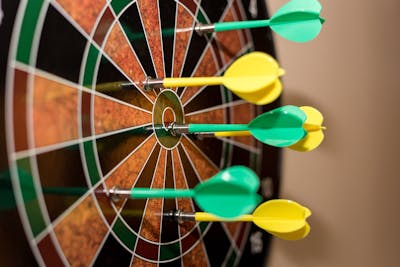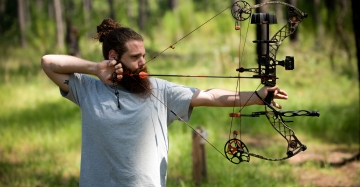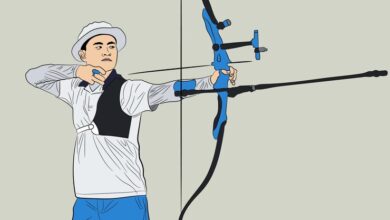What Is A 9-Dart Finish?

In the world of professional darts, scoring a 9-dart finish is considered the ultimate display of skill, precision, and mental fortitude. It is a rare and highly coveted achievement that demonstrates a player’s capability to achieve perfection in a single game.
What Is A 9-Dart Finish? A 9-Dart Finish is also called a “Nine-Darter” in darts. It occurs when a player throws nine perfect darts, starting from a score of 501 and reaching zero in the fewest number of turns possible.
This blog post will delve into the exciting world of darts, explain how it is achieved, and how the legendary players have etched their names in darting history.
How Is A 9-Dart Finish Achieved?
To achieve a 9-dart finish in darts, the player must score a perfect 180 by hitting three successive treble 20s. This will bring the score down to 321.
The player must then hit two more treble 20s, which will lower the score to 141. Finally, the player must aim for a triple 19 with their next dart, which will bring the total down to 24.
There are two ways to end the game: either by hitting two treble 20s with the following two darts or by hitting a triple 20 and double 12 combination.
Achieving a perfect nine-dart finish is considered to be the pinnacle of dartsmanship and requires remarkable talent, concentration, and poise under pressure. It is an extremely difficult feat to accomplish.
What Are There Rules For The 9-Dart Finish?
In the game of darts, playing a perfect game means scoring 501 points and ending with a checkout of nine while using the fewest darts. Although there are no set regulations to achieve a 9-dart finish, players must follow certain principles and standards. These guidelines are as follows:
Firstly, players must launch every dart in a specific order, with no pauses or disturbances between throws.
Secondly, to score the most points possible, all nine darts must land in the treble 20, the red area at the top of the dartboard. The order in which the darts land on Treble 20 is unimportant as long as they all land there.
Finally, the game must begin and end conventionally, with the first dart thrown at double 20 and the last dart landing on a double, typically double 12 or double 18, for a checkout.
Achieving the problematic but attainable 9-dart finish requires incredible accuracy and consistency, highlighting the skills needed to complete this remarkable dart feat.
.
What Is The Significance Of A 9-Dart Finish In Darts?
A 9-dart finish in darts is a truly remarkable achievement that holds immense significance. It refers to a player’s ability to throw nine perfect darts, which is the minimum requirement to win a leg in a five-hundred-point match.
This feat demands exceptional skill, proficiency, and composure under pressure. It is widely considered the pinnacle of darts proficiency because of its rarity.
Due to the high accuracy required, only a few players have accomplished this incredible feat in competitive play. A 9-darter is not only a testament to a player’s exceptional skill but also guarantees them a place in darts history as a legend.
Furthermore, such accomplishments are often associated with iconic moments and are greeted with thunderous cheers from the crowd. The 9-dart finish is a testament to a player’s mastery and ability, cementing their place in the annals of darts history.
Who Are The Most Famous Players In 9 Dart Finishes?
Several renowned players in the world of darts have achieved the coveted feat of a 9-dart finish. Phil Taylor, frequently regarded as the best darts player of all time, is exceptional.
Throughout his distinguished career, Taylor has completed the flawless 9-dart finish multiple times, including in major competitions like the PDC World Championship.
Michael van Gerwen is another well-known figure in the darts community who has made history by accomplishing multiple 9-dart finishes.
Van Gerwen has established himself as one of the best players in the game thanks to his excellent skill and accuracy, which have allowed him to produce these flawless finishes at several tournaments.
Other well-known darters who have achieved the uncommon 9-dart finish are Gary Anderson, Adrian Lewis, and Raymond van Barneveld, all of whom have significantly contributed to the sport with their remarkable darting skills.
These players’ achievements in hitting the magical 9-dart finish have propelled them to legendary status within the darts world. They have been pivotal in cementing their place among the sport’s most famous players.
FAQS:
Is a 9-dart finish rare?
Indeed, in the world of darts, a 9-dart finish is highly uncommon and regarded as a tremendous performance. To succeed, it takes talent, aptitude, and a little bit of luck.
How many players have achieved a 9-dart finish?
In their professional careers, many players have finished with a 9-dart. Although the precise number varies according to the competition or tournament, it is a small group of skilled players.
What happens when a player achieves a 9-dart finish?
It is considered a noteworthy achievement when a player completes a 9-dart finish. Applause and cheers from the crowd are common, and the player is typically awarded a special trophy or bonus.
Are there different ways to achieve a 9-dart finish?
Indeed, there are various approaches to completing a 9-dart finish. It takes just nine darts for players to get the perfect score of 501 by combining different combinations of checkouts and scores.
Wrapping Up:
To wrap up, a 9-dart finish is the ultimate pinnacle of perfection in the game of darts. Accomplishing this feat requires exceptional skill, precision, and nerves of steel.
It is an actual test of a player’s ability to hit the tiny target with incredible accuracy consistently. The rarity of such an achievement adds to its allure and makes it an iconic moment in professional darts tournaments.
Whether you are a casual observer or an avid darts fan, witnessing a 9-dart finish is a thrilling experience showcasing this captivating sport’s very best.


